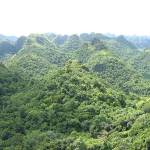When The Roads Were Dirt In Texas
Personal memory by MM De Voe
1977 CE • River Road, College Station, TX, USA
"When I was a kid, I would wait for the school bus every morning shortly after dawn at the side of River Road which was a dirt road in College Station, TX, off Highway 6 on the far side of the airport from town. River Road was lined with dewberry bushes and the horses in their vast horse fields entertained us kids on either side of barbed wire fences held up with reclaimed posts that were rough and weathered gray, and sometimes housed wasp nests and sometimes just roly-polies (pill bugs). Hoot owls called out as dawn broke over the distant horizon and there were always mockingbirds, cardinals and bluejays, probably eating June bugs or some other flying nuisance. The post oaks were the tallest thing on the horizon, fat dwarfs with enormous broccoli-shaped heads, they were the only shade in summer but their leaves were so dark, glossy and dense that beneath the tree the temperature was ten degrees cooler than in the sun. I remember adults with their Texan twangs discussing how the roots of a post oak were as tall as the tree, and I was fascinated by the idea of every tree being mirrored by a shadow tree sticking deep into the red clay underground. Now in that neighborhood, the houses are thick and the roads paved for the huge pickup trucks with their oversized tires and rifle racks. Oil wells about our old property and the well water in the bathroom and kitchen taps reeks of sulfur. The two ponds on the property have dried up to nothing and the lawn is riddled with fierce colonies of fire ants. No one has seen an armadillo or a possum in years and the horse fields have been broken up with a net of paved roads and new housing developments. The songbirds have been replaced with planes and buzzards. Tiny Easterwood airport is now George Bush International and instead of a dirt road with a two-way stop—the turn is off a four-lane highway . . ."
Image: Nicolas Henderson via Flickr, Attribution 2.0 Generic (CC BY 2.0)


Learn about Maya Lin’s fifth and final memorial: a multi-platform science based artwork that presents an ecological history of our world - past, present, and future.

Discover ecological histories and stories of former abundance, loss, and recovery on the map of memory.

Learn how we can reduce our emissions and protect and restore species and habitats – around the world.

See how art can help us rethink the problems we face, and give us hope that each one of us can make a difference.

Help make a global memorial something personal and close to home. Share your stories of the natural world.


